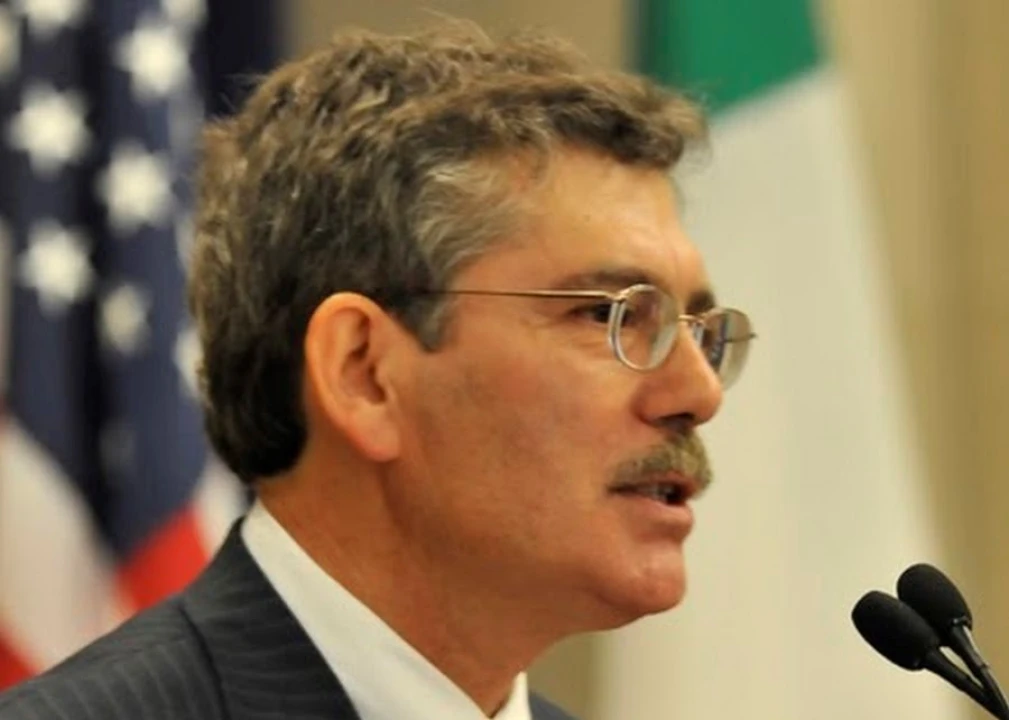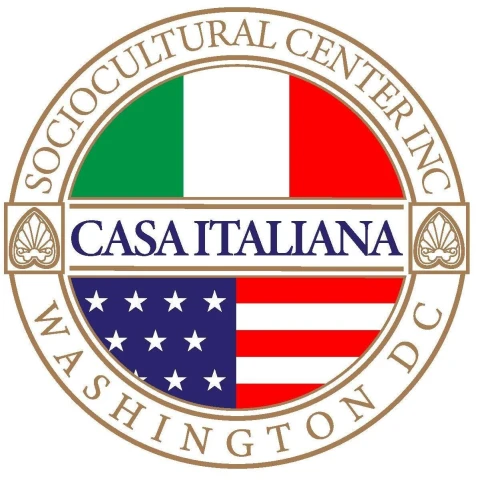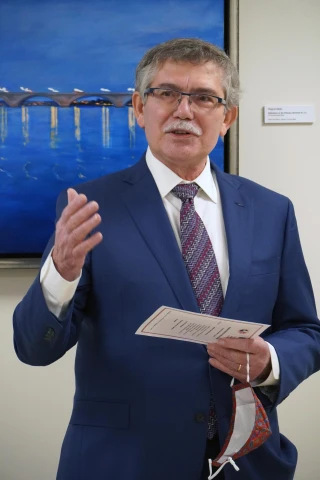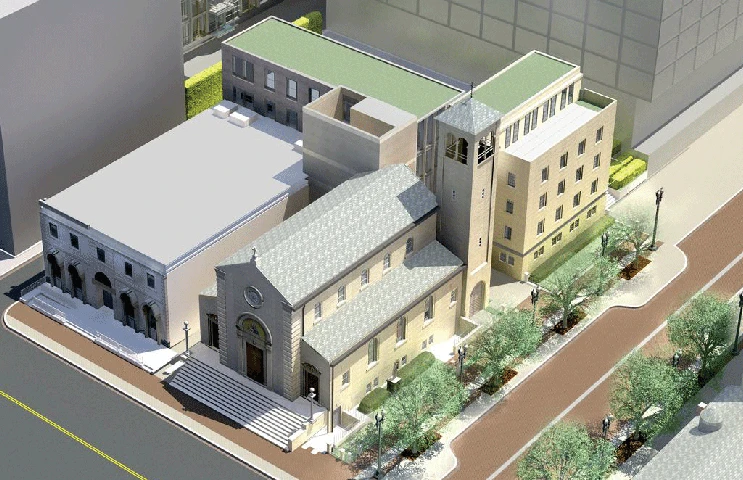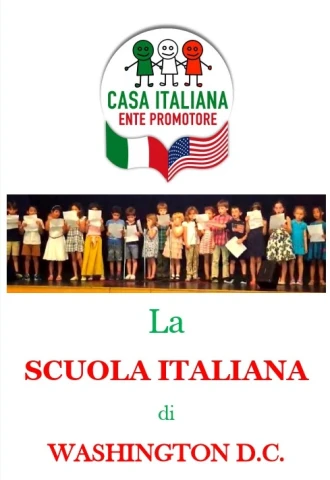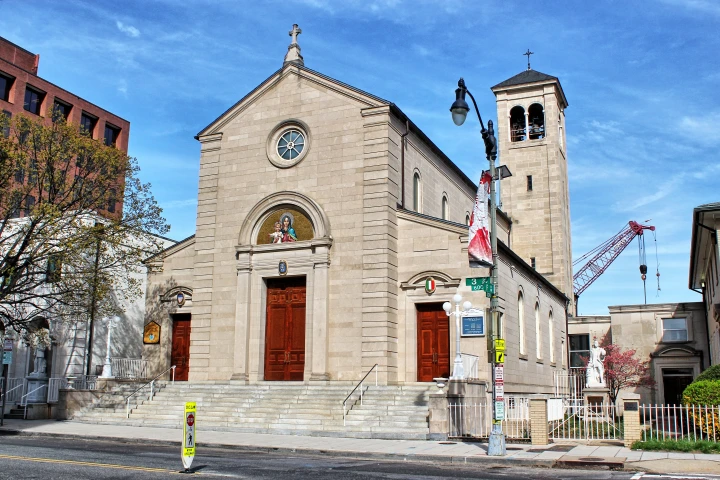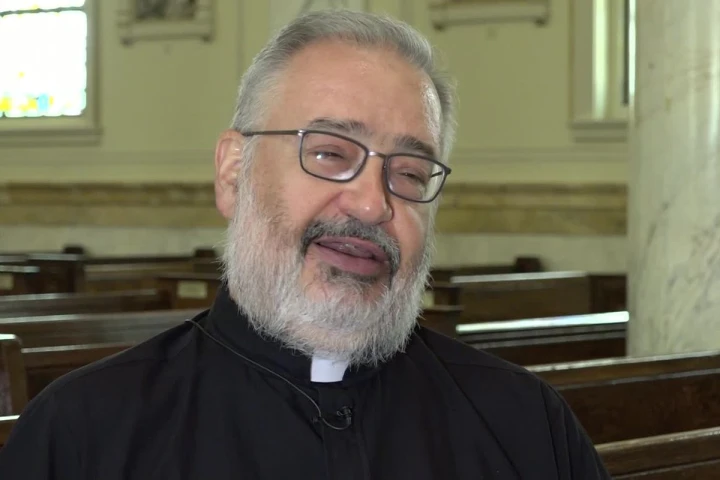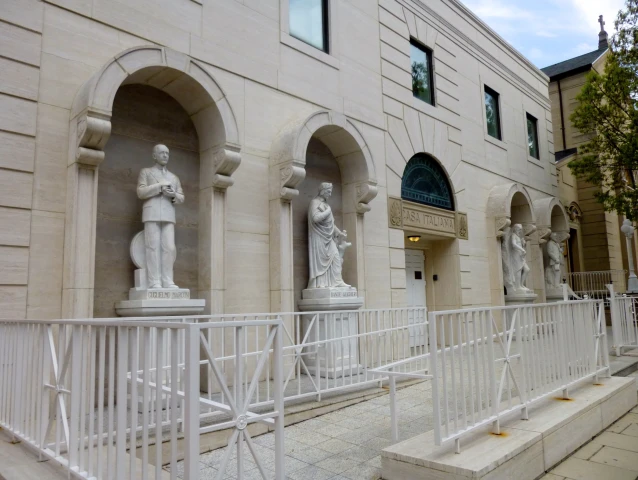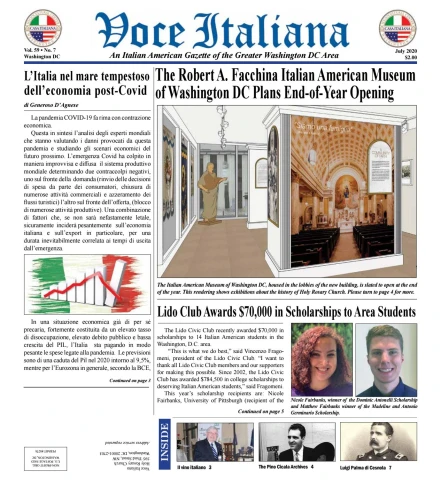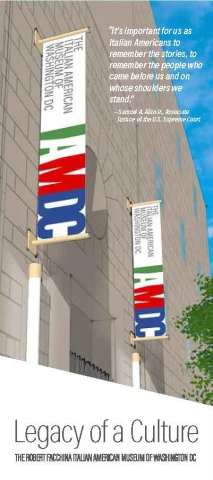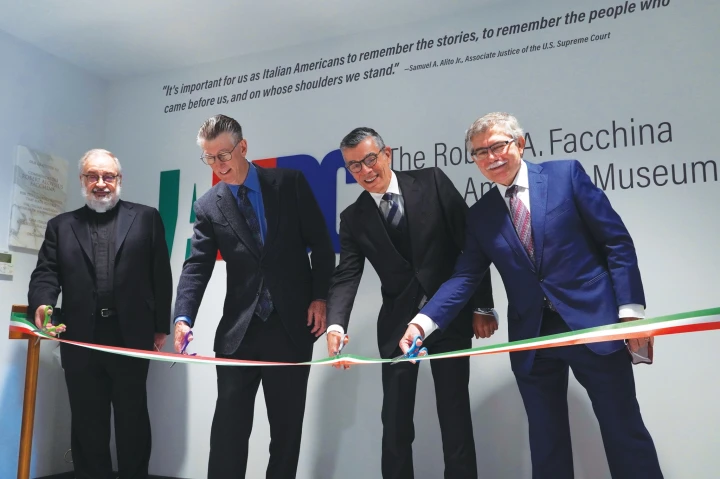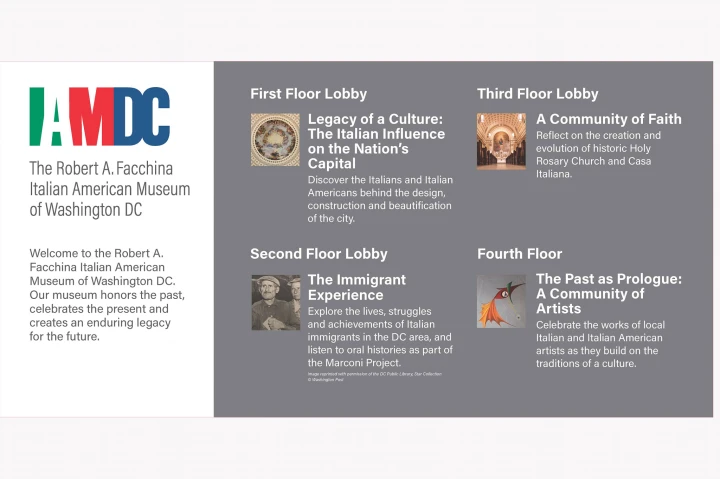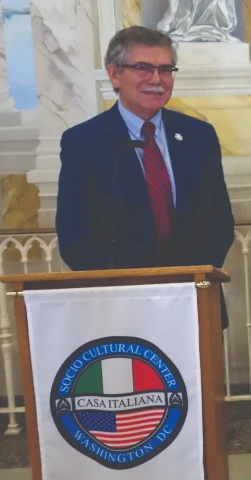There are almost twenty museums of Italian emigration to America, and another one has recently been inaugurated. It is part of a wonderful complex in the US Capital, Washington DC.
I am pleased to have Francesco Isgrò as guest and protagonist of this interview, President of this wonderful new place that celebrates the Italian American experience and the remarkable contribution of our fellow Italians who emigrated to Washington. Welcome on We the Italians!
Francesco, you are the President of the Casa Italiana Sociocultural Center Inc. Please help our readers understand your personal history and the history and the mission of your organization
First of all, thank you for your interest in the Casa Italiana Sociocultural Center in Washington, D.C., and our programs and projects.
My personal history begins in Terme-Vigliatore, a coastal town near Milazzo, Sicily, where I was born. When I was a teenager, my parents moved our family to Schenectady, New York, where my grandfather and other relatives were living. It’s a common immigration theme, of course, the importance of families being together. My first residence in the U.S. was New York but, in fact, my home for the past 40-plus years has been Washington, D.C.
After college I joined the U.S. Peace Corps Volunteer program and was sent to Central African Republic to teach for two years. It was almost accidentally that on a visit to D.C., following my return from Africa, I decided to stay here and study law. Shortly after getting my law degree I took a position at the Department of Justice, where I spent my 40-year career as an attorney in various positions within the field of immigration law. For 30 years, I was also an adjunct professor of immigration law at several local law schools.
On a volunteer and social basis, I've been very involved in the Italian American community with various groups and activities. For example, Holy Rosary Church, the national Italian parish, has been a point of reference for many Italians and Italian Americans in the city for more than a century, and Casa Italiana, next door to the church, provides a social and cultural element for the community. When Father Ezio Marchetto was assigned pastor in 2013, he accelerated the diverse cultural activities at Casa Italiana, while overseeing the expansion of the complex with the addition of a new multi-purpose building. After my retirement from the Justice Department, I focused more fully on the Casa Italiana activities.
A few years ago, we created a separate non-profit organization called Casa Italiana Sociocultural Center Inc. to institutionalize the cultural programs and events. My role as president and CEO, as well as those of our generous and talented board and staff, is entirely on a volunteer basis. Our goal is to support Italian-related cultural activities not only at Casa Italiana but also in the greater Washington area, and to present, promote and celebrate the best of Italian culture. So, when Father Marchetto, a history afficionado, expressed the idea of creating a small museum in the nation’s capital, which is so rich in Italian influences, I was totally on board. We started in late 2017 with a few volunteers who worked full time on the project. We are very proud to say that by the end of 2020, we had completed the museum and we held a symbolic ribbon-cutting for the launching of the new Italian American Museum of Washington DC (IAMDC).
You also have a Casa Italiana Language School and an Ente Promotore. Tell us about them.
When the old Casa Italiana hall was built in 1981, then-pastor Father Caesar Donanzan established language classes, the scuola italiana. The late Dr. Maria Wilmeth, a great personality here, became the first director of the formal Casa Italiana Language School. Eventually the language school also became a separate nonprofit entity, managed for many years by Dr. Joe Lupo. Today, the Casa Italiana Language School is directed by Faduma Ali and teaches around 1400 students. There are language classes of varying levels, literature and culture classes, as well as cooking classes and ceramic classes.
Subsequently, Casa Italiana also became an ente promotore. This separate program focuses on promoting and supporting the teaching of Italian in local high schools. It is currently headed by Paola Corneo.
I know that you have a wonderful library with 2500 Italian American books and several DVDs and I think that this is very important. Can you please tell me more about this?
We actually have several libraries, which we intend to expand. One is a large library of books in Italian, beautifully catalogued that visitors can borrow from. We also have a large collection of children's Italian books and are now in the process of establishing an Italian American library, in which we want to showcase, support and promote Italian American authors and those, like you, who write about Italian Americans. In the post-covid future, one of our goals is to invite authors to make book presentations at the library, since we now have the space and excellent location.
Tell me a bit more about the connection between the new Casa Italian Sociocultural Center building, and Holy Rosary Church and Father Ezio Marchetto.
The major inspiration for many of the new cultural projects was Father Ezio Marchetto. He understood that the influence of the Italian culture in Washington is pervasive and yet its history is little-known. For instance, few people know that the city was not only highly influenced by Italian art and architecture, but was also built my many Italian hands, who left a huge legacy.
A major change in our complex, came about five years ago, when a large construction project was changing the landscape of the area around the church and Casa Italiana. The project developers acquired some of the church’s land to complete the project, and compensated by constructing a large multi-purpose building adjacent to the church. The new building houses office space for the church and Casa Italiana, language and cultural classes under the Casa Italiana Language School, as well as the Italian American Museum of Washington DC, and a large piazza that will be used for outdoor cultural and social events. The Casa Italiana Sociocultural Center Inc. supports and oversees certain cultural events and programs, such as the Marconi Project of oral histories, as well as the museum and an archive collection.
Father Marchetto was recently elevated by his Scalabrinian Order to be Provincial Bursar for the St. Charles Borromeo Province and has relocated to New York City. His replacements are Father Pietro Paolo Polo and Father Andrei Zanon, who look forward to building on the deep religious and cultural traditions of our community.
Correct me if I’m wrong, but it’s not easy to have this kind of space in D.C.
That’s absolutely true. Holy Rosary Church and Casa Italiana are located in a great area: two blocks from the Union train station, a few blocks from the U.S. Capitol, and across the street from a Metro station. Furthermore, the Jewish museum is now being constructed near the historic synagogue just across from our complex. We are also close to the German American Museum, the National Building Museum, as well as the Smithsonian Museums at the national Mall.
What’s your Marconi Project?
One of the projects of the Casa Italiana Sociocultural Center Inc. is our ongoing Marconi Project, oral histories of Italian immigrants to the area and their descendants. They share their life stories and their challenges and achievements. We especially want to capture the stories of the earlier immigrants since their numbers are dwindling and it’s important to preserve how being Italian affected their lives in D.C. and the challenges they may have faced. Washington is home to many interesting Italian Americans. Among those we have interviewed are: the grandson of Luigi Einaudi, the first President of the Italian Republic; the Italian-born owner of the stone company that built the Vietnam memorial; an Italian American entrepreneur who helped develop huge parts of the city; and about a dozen others so far. I believe we need the voices of the past to help us understand the present and plan for the future.
After 14 years you recently left Voce Italiana, please tell us more about it.
Voce Italiana began publishing in 1961 under the direction of Azione Cattolica as the Holy Rosary Church newsletter. Over the years, it developed and evolved into a more generalized publication. In 2007, Father Lydio F. Tomasi, who was at the Center for Migration Studies in New York, was assigned to Holy Rosary (his brother, Silvano Tomasi was recently elevated to Cardinal). Father Lydio greatly expanded the paper and moved it to a digital platform. I had known Father Lydio for many years through my legal work in immigration, and he asked me to become Executive Editor. Over the past 14 years in that position, my particular interest was to diversify the newspaper so that it embraces the entire local community. In the end, I believe our team achieved our objectives and produced a quality, diversified, interesting newspaper about our Italian American community and beyond.
The new editor of Voce Italiana as of January is Paola Corneo, who is assisted by a new team. I think it's important to hear other voices reporting and writing articles of interest to the community.
In your activities in Washington, do you meet more Italians born in Italy who now work in some international institution, or more Italian Americans, people born in America with Italian origins?
The core of the community membership is Italian American. In the past few years, however, we have seen an increase of Italian natives working at various international institutions. These increasing number of Italians bring a wonderful view of contemporary Italy with them but many are in the area temporarily and then move on to other posts. Members of the Italian American community, on the other hand, have deep and strong ties here.
Tell us more about this new, beautiful museum you recently opened: the Robert A. Facchina Italian American Museum of Washington DC. I want to know everything about it!
The inauguration of the Italian American Museum of Washington, DC on December 14, 2020, was an historic day for our Italian and Italian American community. While we were engaged in creating the Casa Italiana Sociocultural Center, Inc., and garnering financial support from our community, as I mentioned, Father Marchetto suggested that one of our projects should be to establish a museum, housed in the new building, about the local Italian American community.
We formed a team to work on the project and thanks to a generous gift from Commendatore Robert A. Facchina, the dream became a reality. To show our appreciation to Mr. Facchina, we named the museum in his honor. Furthermore, the Facchina family has strong roots in the community, dating back to the early days of the formation of Holy Rosary Church, more than 100 years ago.
The museum has a vertical footprint: exhibitions are found on each of the four lobby areas, as well as in some separate rooms and galleries. As you enter the museum, we display the names of the more than 100 generous donors “founders,” who contributed to Casa Italiana. We have a quote on the wall by U.S. Supreme Court Justice Samuel Alito that sets the tone. His words read: “It is important for us Italian Americans to remember the stories, to remember the people who came before us and on whose shoulders we stand.”
Many in D.C. are not aware of the challenges, tribulations, or achievements of Italian Americans in the city. In large numbers, they helped build monuments, offices, government buildings, bridges. They helped build the city, and then Italian sculptors and stone cutters helped beautify it.
As you enter the first-floor lobby, there is a beautiful large wall map of Washington, D.C. that points to 30 of the many sites that were created by or somehow touched by Italian hands. A few examples: the statue of Dante, carved by a Sicilian sculptor, is located in a city park; the six statues in front of Union Station were carved in 1910 by Andrew Bernasconi, whose descendants are still in the area; and the huge statue of Lincoln in the Lincoln Memorial was carved by the Piccirilli brothers, who did numerous other carvings throughout the city. Our map also includes various museums in the city with their outstanding collections of Italian art and artifacts.
Next to the map is a display case that honors Italian and Italian American stone workers and carvers. You can see some of the tools that were used to construct the Vietnam memorial by a stone company started by an Italian immigrant, as well as an original piece of column carved by an Italian in the late 1860s for the U.S. Capitol. A modern artist and sculptor named Davide Prete created the 3D reproduction, also on display, of another Capitol column created by Italians in the 19th century.
The second-floor space is dedicated to the immigrant experience – the everyday lives of the early Italians in D.C. A large timeline tracks the arc of Italian immigration to the city going back to Thomas Jefferson who first recruited Italians to beautify the growing city and Italian musicians to play in the President’s Marine Corps Band. Cases include family artifacts donated by local descendants of immigrants to the area.
The third floor is devoted to the history of the local community—of the century-old old Holy Rosary Church and the Casa Italiana, which opened in 1981. Beautiful religious artifacts are on display here.
The fourth floor harkens back to the first in celebrating Italian artistry but displays artwork by modern artists. We asked for art donations and about 30 artists came forward and their works are displayed in these galleries – from modern art to mosaics to ceramics. Our objective here is to promote local Italian American artists.
We are very proud that our museum is the only one in the country that, as Italian Ambassador Armando Varricchio stated on our inauguration day, “showcases the contributions that Italians and Italian Americans have made in the Nation’s Capital.”
As we said, your area of influence is Washington, District of Columbia. Today in the capital some want to delete references to Columbus, following the attacks and violence against statues in different parts of America. What are your thoughts on all this?
In recent years, Columbus has become highly politicized, and used by one side or the other to represent something ideological, not cultural. We celebrate him because he instills a sense of pride in us Italian Americans. We celebrate Columbus because when our ancestors and other Italian immigrants were discriminated against, they had a hero to lift them up, and they could say with pride that Columbus, an Italian, had discovered America. We now need to tell our stories of what Columbus means to our community and why we erected statues of him across America. The fact is that we are all here because an Italian navigator opened the doors to European migration.
Columbus was not a perfect man, but instead of destroying his historical significance and the statues, let's all learn from his missteps and challenges. The past should serve as our guide toward a better future.
We will definitely proudly continue to celebrate Columbus in Washington for what he represents to us. We have a beautiful statue of the young Columbus in our new piazza, a statue that was donated by the Lido Civic Club, a local Italian American institution in the capital for more than 90 years. Each year we gather around the statue, and by remembering Columbus we also recall the history of Italian Americans in America and we celebrate their many contributions.
Sono quasi venti i musei dell'emigrazione italiana in America, e da poco se ne è aggiunto un altro. E' parte di un meraviglioso complesso nella capitale degli Stati Uniti, Washington DC.
Ho il piacere di avere ospite e protagonista di questa intervista Francesco Isgrò, Presidente di questo nuovo meraviglioso luogo che celebra l'esperienza italoamericana e il notevole contributo dei nostri concittadini italiani emigrati a Washington. Benevuto su We the Italians!
Francesco, tu sei il Presidente di Casa Italiana Sociocultural Center Inc. Ti chiediamo di aiutare i nostri lettori a conoscere la tua storia personale e la storia e la missione della vostra organizzazione
Prima di tutto, grazie per il vostro interesse nel Casa Italiana Sociocultural Center di Washington DC, e nei nostri programmi e progetti.
La mia storia personale inizia a Terme-Vigliatore, una città costiera vicino a Milazzo, Sicilia, dove sono nato. Quando ero adolescente, la mia famiglia si trasferì a Schenectady, New York, dove vivevano mio nonno e altri parenti. È un tema comune dell'immigrazione, naturalmente, l'importanza delle famiglie che stanno insieme. La mia prima residenza negli Stati Uniti è stata New York, ma, in realtà, la mia casa negli ultimi 40 anni e più è stata Washington, DC.
Dopo il college mi sono unito ai U.S. Peace Corps Volunteer e sono stato inviato nella Repubblica Centrafricana per insegnare per due anni. È stato quasi per caso che durante una visita a Washington, dopo il mio ritorno dall'Africa, ho deciso di rimanere qui e studiare legge. Poco dopo aver conseguito la laurea in legge, ho accettato un posto al Dipartimento di Giustizia, dove ho trascorso i miei 40 anni di carriera come avvocato in varie posizioni nel campo della legge sull'immigrazione. Per 30 anni sono stato anche professore aggiunto di diritto dell'immigrazione in diverse scuole di legge locali.
A livello di volontariato e sociale, sono stato molto coinvolto nella comunità italoamericana con vari gruppi e attività. Per esempio, la Holy Rosary Church, la parrocchia nazionale italiana, è stata un punto di riferimento per molti italiani e italoamericani in città per più di un secolo, e Casa Italiana, accanto alla chiesa, fornisce un elemento di aiuto sociale e culturale per la comunità. Quando Padre Ezio Marchetto è stato nominato parroco nel 2013, ha accelerato le diverse attività culturali di Casa Italiana, supervisionando l'espansione del complesso con l'aggiunta di un nuovo edificio polifunzionale. Dopo il mio ritiro dal Dipartimento di Giustizia, mi sono concentrato maggiormente sulle attività di Casa Italiana.
Alcuni anni fa, abbiamo creato un'organizzazione separata senza scopo di lucro chiamata Casa Italiana Sociocultural Center Inc. per istituzionalizzare i programmi e gli eventi culturali. Il mio ruolo come Presidente e Amministratore Delegato, così come quelli del nostro generoso e talentuoso consiglio e del personale, è interamente su base volontaria. Il nostro obiettivo è quello di sostenere le attività culturali legate all'Italia non solo a Casa Italiana, ma anche nella area di Washington e dintorni, e di presentare, promuovere e celebrare il meglio della cultura italiana. Così, quando Padre Marchetto, un appassionato di storia, ha espresso l'idea di creare un piccolo museo nella capitale della nazione, che è così ricca di influenze italiane, la cosa mi ha visto assolutamente entusiasta. Abbiamo iniziato alla fine del 2017 con alcuni volontari che hanno lavorato a tempo pieno al progetto. Siamo molto orgogliosi di dire che alla fine del 2020 avevamo completato il museo e abbiamo tenuto un simbolico taglio del nastro per il lancio del nuovo Italian American Museum of Washington DC (IAMDC).
Avete anche una Casa Italiana Language School e un Ente Promotore. Ci parli di loro?
Quando la vecchia struttura di Casa Italiana fu costruita nel 1981, l'allora parroco Padre Caesar Donanzan istituì le classi di lingua, la scuola italiana. La defunta Dr. Maria Wilmeth, una grande personalità di questa comunità, divenne la prima direttrice della scuola di lingua di Casa Italiana. Alla fine la scuola di lingua divenne anche un'entità separata senza scopo di lucro, gestita per molti anni dal Dr. Joe Lupo. Oggi, la Casa Italiana Language School è diretta da Faduma Ali e insegna a circa 1400 studenti. Ci sono lezioni di lingua di vari livelli, lezioni di letteratura e cultura, così come lezioni di cucina e di ceramica.
Successivamente, Casa Italiana è diventata anche un ente promotore. Questo programma separato si concentra sulla promozione e il sostegno dell'insegnamento dell'italiano nelle scuole superiori locali. Attualmente l’ente promotore è diretto da Paola Corneo.
So che avete una meravigliosa biblioteca con 2500 libri italoamericani e diversi DVD e penso che questo sia molto importante...
In realtà abbiamo diverse biblioteche, che abbiamo intenzione di ampliare. Una è una grande biblioteca di libri in italiano, splendidamente catalogati, che i visitatori possono prendere in prestito. Abbiamo anche una grande collezione di libri italiani per bambini e siamo in procinto di istituire una biblioteca italoamericana, in cui vogliamo mostrare, sostenere e promuovere gli autori italoamericani e quelli, come te, che scrivono di italoamericani. Nel futuro post-covid, uno dei nostri obiettivi è quello di invitare gli autori a fare presentazioni di libri in biblioteca, dato che ora abbiamo lo spazio e una eccellente posizione.
Mi dici un po' di più sul legame tra il nuovo edificio di Casa Italian Sociocultural Center, la Holy Rosary Church e Padre Ezio Marchetto?
L'ispirazione principale per molti dei nuovi progetti culturali è stato Padre Ezio Marchetto. Fu lui che capì per primo che l'influenza della cultura italiana a Washington è pervasiva e tuttavia la sua storia è poco conosciuta. Per esempio, pochi sanno che la città non solo è stata fortemente influenzata dall'arte e dall'architettura italiana, ma è stata anche costruita da molte mani italiane, che hanno lasciato un'enorme eredità.
Un grande cambiamento nel nostro complesso è avvenuto circa cinque anni fa, quando un grande progetto di costruzione stava cambiando il paesaggio della zona intorno alla chiesa e a Casa Italiana. Gli sviluppatori del progetto hanno acquisito parte del terreno della chiesa per completare il progetto, e hanno compensato questa acquisizione costruendo un grande edificio multiuso adiacente alla chiesa. Il nuovo edificio ospita spazi per uffici per la chiesa e Casa Italiana, classi di lingua e cultura grazie alla Casa Italiana Language School a, così come l’Italian American Museum of Washington DC, e c’è anche una grande piazza che sarà usata per eventi culturali e sociali all'aperto. La Casa Italiana Sociocultural Center Inc. sostiene e supervisiona alcuni eventi e programmi culturali, come il Marconi Project, il museo e una collezione di archivi.
Padre Marchetto è stato recentemente promosso dal suo Ordine Scalabriniano a Economo Provinciale della Provincia di San Carlo Borromeo e si è trasferito a New York City. I suoi sostituti sono Padre Pietro Paolo Polo e Padre Andrei Zanon, che non vedono l'ora di arricchire le profonde tradizioni religiose e culturali della nostra comunità.
Correggimi se sbaglio, ma credo non sia facile avere questo tipo di spazio a Washington DC...
Questo è assolutamente vero. La Holy Rosary Church e Casa Italiana sono situate in un'ottima zona: a due isolati dalla stazione ferroviaria Union Station, a pochi isolati dal Campidoglio e di fronte a una stazione della metropolitana. Inoltre, il museo ebraico è in costruzione vicino alla storica sinagoga proprio di fronte al nostro complesso. Siamo anche vicini al Museo Tedesco-Americano, al National Building Museum e ai Musei Smithsoniani del National Mall.
Cos’è il vostro Marconi Project?
Uno dei progetti della Casa Italiana Sociocultural Center Inc. è il nostro Marconi Project, storie orali di immigrati italiani nella zona e dei loro discendenti. Condividono le loro storie di vita, le loro sfide e i loro successi. Vogliamo soprattutto registrare le storie dei primi immigrati poiché il loro numero sta diminuendo ed è importante preservare come l'essere italiani abbia influenzato le loro vite a Washington e le sfide che possono aver affrontato. Washington DC è la patria di molti italoamericani interessanti. Tra quelli che abbiamo intervistato ci sono: il nipote di Luigi Einaudi, il primo presidente della Repubblica Italiana; il proprietario di origine italiana dell'azienda lapidea che ha costruito il Vietnam Memorial; un imprenditore italoamericano che ha contribuito a sviluppare vaste aree della città; e circa una dozzina di altri finora. Credo che abbiamo bisogno delle voci del passato per aiutarci a capire il presente e pianificare il futuro.
Dopo 14 anni tu hai recentemente lasciato il giornale Voce Italiana: ce ne parli un po’?
Voce Italiana ha iniziato a pubblicare nel 1961 sotto la direzione dell’Azione Cattolica come newsletter della Holy Rosary Church. Nel corso degli anni, si è sviluppata e si è evoluta in una pubblicazione più generalizzata. Nel 2007, padre Lydio F. Tomasi, che si trovava al Center for Migration Studies di New York, fu assegnato alla Holy Rosary Church (suo fratello, Silvano Tomasi è stato recentemente elevato a cardinale). Padre Lydio ampliò notevolmente il giornale e lo trasferì su una piattaforma digitale. Conoscevo padre Lydio da molti anni grazie al mio lavoro legale nel campo dell'immigrazione, e lui mi chiese di diventare redattore esecutivo. Negli ultimi 14 anni in quella posizione, il mio particolare interesse è stato quello di diversificare il giornale in modo che abbracciasse l'intera comunità locale. Alla fine, credo che il nostro team abbia raggiunto i nostri obiettivi e prodotto un giornale di qualità, diversificato e interessante che descrive la nostra comunità italoamericana e non solo.
Il nuovo editore di Voce Italiana da gennaio è Paola Corneo, che è assistita da una nuova squadra. Penso che sia importante sentire altre voci che riportano e scrivono articoli di interesse per la comunità.
Nelle vostre attività a Washington DC, incontrate più italiani nati in Italia che ora lavorano in qualche istituzione internazionale, o più italoamericani, persone nate in America con origini italiane?
Il nucleo della comunità è italoamericano. Negli ultimi anni, tuttavia, abbiamo visto un aumento dei nativi italiani che lavorano in varie istituzioni internazionali. Questi sempre più numerosi italiani portano con sé una meravigliosa visione dell'Italia contemporanea, ma molti sono in zona temporaneamente e poi passano ad altri incarichi. I membri della comunità italoamericana, d'altra parte, qui hanno legami profondi e forti.
Dicci di più su questo nuovo, bellissimo museo che ha aperto di recente: il Robert A. Facchina Italian American Museum di Washington DC. Voglio sapere tutto!
L'inaugurazione dell'Italian American Museum di Washington DC il 14 dicembre 2020 è stato un giorno storico per la nostra comunità italiana e italoamericana. Mentre eravamo impegnati a creare Casa Italiana Sociocultural Center Inc. e a raccogliere il sostegno finanziario della nostra comunità, come ho accennato, Padre Marchetto suggerì che uno dei nostri progetti doveva essere quello di istituire un museo, ospitato nel nuovo edificio, sulla comunità italoamericana locale.
Abbiamo formato una squadra per lavorare al progetto e grazie ad una generosa donazione del Commendatore Robert A. Facchina, il sogno è diventato realtà. Per mostrare il nostro apprezzamento al Commendator Facchina, abbiamo intitolato il museo in suo onore. Inoltre, la famiglia Facchina ha forti radici nella comunità, e risale ai primi giorni della formazione della Holy Rosary Church, più di 100 anni fa.
Il museo ha un'impostazione verticale: le mostre si trovano in ognuna delle quattro aree dell'atrio, così come in alcune stanze e gallerie separate. Entrando nel museo, mostriamo i nomi degli oltre 100 generosi donatori "fondatori" che hanno contribuito a Casa Italiana. Abbiamo una citazione sul muro del giudice della Corte Suprema degli Stati Uniti Samuel Alito che dà il benvenuto. Le sue parole recitano: "È importante per noi italoamericani ricordare le storie, ricordare le persone che sono venute prima di noi e sulle cui spalle ci troviamo".
Molti a Washington DC non sono consapevoli delle sfide, dei problemi o dei successi degli italoamericani in città. In gran numero, hanno aiutato a costruire monumenti, uffici, edifici governativi, ponti. Hanno aiutato a costruire la città, e poi gli scultori e gli scalpellini italiani hanno contribuito ad abbellirla.
Entrando nell'atrio del primo piano, c'è una bella e grande mappa a muro di Washington DC che indica 30 dei molti siti che sono stati creati o in qualche modo toccati da mani italiane. Alcuni esempi: la statua di Dante, scolpita da uno scultore siciliano, si trova in un parco cittadino; le sei statue di fronte alla Union Station furono scolpite nel 1910 da Andrew Bernasconi, i cui discendenti sono ancora in zona; e l'enorme statua di Lincoln nel Lincoln Memorial fu scolpita dai fratelli Piccirilli, che fecero numerose altre sculture in tutta la città. La nostra mappa include anche vari musei della città con le loro eccezionali collezioni di arte e manufatti italiani.
Accanto alla mappa c'è una vetrina che onora i lavoratori della pietra e gli intagliatori italiani e italoamericani. Si possono vedere alcuni degli strumenti che sono stati utilizzati per costruire il Vietnam Memorial da una società di pietra avviata da un immigrato italiano, così come un pezzo originale di colonna scolpito da un italiano alla fine del 1860 per il Campidoglio degli Stati Uniti. Un artista e scultore moderno di nome Davide Prete ha creato la riproduzione in 3D, anch'essa in mostra, di un'altra colonna del Campidoglio creata da italiani nel XIX secolo.
Lo spazio al secondo piano è dedicato all'esperienza degli immigrati - la vita quotidiana dei primi italiani a Washington DC. Una grande linea del tempo traccia l'arco dell'immigrazione italiana in città risalendo a Thomas Jefferson che per primo reclutò italiani per abbellire la città in crescita e musicisti italiani per suonare nella President's Marine Corps Band. Le teche includono manufatti di famiglia donati dai discendenti locali degli immigrati nella zona.
Il terzo piano è dedicato alla storia della comunità locale della centenaria Holy Rosary Church e di Casa Italiana, aperta nel 1981. Qui sono esposti bellissimi artefatti religiosi.
Il quarto piano si riallaccia al primo per celebrare l'arte italiana, ma espone opere d'arte di artisti moderni. Abbiamo chiesto donazioni d'arte e circa 30 artisti si sono fatti avanti e le loro opere sono esposte in queste gallerie - dall'arte moderna ai mosaici alla ceramica. Il nostro obiettivo è quello di promuovere gli artisti italoamericani locali.
Siamo molto orgogliosi che il nostro museo sia l'unico nel Paese che, come ha dichiarato l'Ambasciatore italiano Armando Varricchio il giorno dell'inaugurazione, "mette in mostra i contributi che gli italiani e gli italoamericani hanno dato nella capitale della nazione".
Come abbiamo detto, la vostra area di influenza è Washington, District of Columbia. Oggi nella capitale alcuni vogliono cancellare il riferimento a Colombo, dopo gli attacchi e le violenze contro le statue in diverse parti d'America. Qual è il tuo pensiero su tutto questo?
Negli ultimi anni, Colombo è stato enormemente politicizzato, e usato da una parte o dall'altra per rappresentare qualcosa di ideologico, non culturale. Noi lo celebriamo perché infonde un senso di orgoglio in noi italoamericani. Festeggiamo Colombo perché quando i nostri antenati e altri immigrati italiani venivano discriminati, avevano un eroe che li rappresentava, e potevano dire con orgoglio che Colombo, un italiano, aveva scoperto l'America. Ora abbiamo bisogno di raccontare le nostre storie su cosa significa Colombo per la nostra comunità e perché abbiamo eretto statue di lui in tutta l'America. Il fatto è che siamo tutti qui perché un navigatore italiano ha aperto le porte alla migrazione europea.
Colombo non era un uomo perfetto, ma invece di distruggere il suo significato storico e le statue, dovremmo imparare tutti dai suoi passi falsi e dalle sue sfide. Il passato dovrebbe servirci come guida verso un futuro migliore.
Sicuramente continueremo con orgoglio a celebrare Colombo a Washington DC per quello che rappresenta per noi. Abbiamo una bellissima statua del giovane Colombo nella nostra nuova piazza, una statua che è stata donata dal Lido Civic Club, un'istituzione locale italoamericana che ha operato nella capitale per più di 90 anni. Ogni anno ci riuniamo intorno alla statua, e ricordando Colombo ricordiamo anche la storia degli italoamericani in America e celebriamo i loro numerosi contributi.


